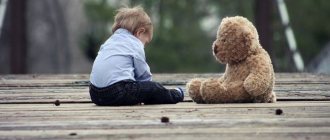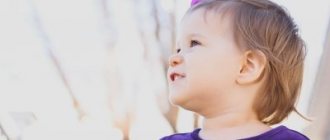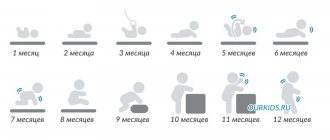Physical development of a child at 11 months
At 11 months, the baby's weight is approximately 9 to 12 kg. The baby has grown a lot in 11 months and his height ranges from 72 to 76 cm. If you measure his chest circumference, it will be 44-46 cm, and his head circumference will be 45-46 cm. He is proportionally built and quite strong, to walk holding mother’s hand, carefully step over low obstacles, climb the wall bars (of course, only the lowest bars) and even hang for a short time on rings or a children’s horizontal bar, tenaciously grasping with your hands.
Of course, these indicators should not suddenly fill you with anxiety about the development of your baby. Children develop very individually, and if your baby is not even going to start walking yet, that’s normal - he will, but a little later. In fact, according to some medical data, at 11 months, children should stand on their own for only a few seconds.
If your baby is not a restless child and wants to walk on his own, then it’s time to buy shoes. It should be quite soft, especially with a sole reminiscent of the well-known Czech shoes. In the future, take care to buy stiffer shoes with arch supports to avoid problems with flat feet. And you shouldn’t skimp on shoes.
The 11-month-old baby loves to overcome various obstacles, climbing on armchairs, sofas, tables and chairs. Of course, there are some falls and bruises here. You need to be careful when assessing the baby's injuries. If he whines - rather from resentment and indignation, because he didn’t manage to do the thing he wanted - don’t rush to rush to his aid and feel sorry for him (while “punishing” the object that is responsible for the failure: “Wow, what a chair ! Here you go! "). A certain number of failures and the ability to cope with them independently is the key to a person’s success in the future, and it is laid down right from the very first conscious months of a baby’s life. In such cases, try to simply switch the child’s attention to another object: “Look, look, what kind of dog is running!”
And your baby can probably stand on his toes and squat, bend over and sit down even from a standing position. It won't be particularly difficult for him to take off his socks. Do you see how big and smart he is already?
Skills of a child at 11 months
Let's see what your baby has achieved by 11 months of development:
- he pronounces some words imitating the voices of animals and birds;
- understands what you say to him and everything that happens around him;
- he carries out simple tasks: bring, serve, take, carry;
- loves when his actions are approved, and is dissatisfied when there is no approval;
- knows how to nod his head affirmatively and shake it negatively;
- understands the connection of an object to a place: a flower in a vase, a dog in a booth;
- can use both hands, while understanding which hand works better;
- perfectly copies your intonations;
- using syllables, maintains a “conversation”;
- is subject to mood swings, which determine how much he wants to communicate with you at the moment;
- understands well that he has done something wrong and can express it;
- “reads” by leafing through book pages;
- Excellent use of cutlery when eating.
From gesture to word
Look how a one-year-old baby behaves. If he wants to play with the dog, he looks at it, then turns to his mother to “express” his desire. But the baby dropped something on the floor and immediately raises his hands up and screams. This in itself is a small achievement, but it leads to a serious conclusion. The child understands that if he is unable to do something himself, he can ask someone else to do it. And if recently the baby tried to do this with the help of gestures or individual sounds, now he is more and more confident in pronouncing phrases like “give-give”, “mom”, etc. At the same time, he imitates you with pleasure. It's worth taking advantage of this. Try to attract the baby's attention to you and, looking into his eyes, say the same syllable 5 times with an interval of 10 seconds (for example, “ma”, “pa” or “ba”). The baby will certainly repeat this syllable after you. Then say the next syllable, and after waiting for an answer, say the third. The child will repeat it again after you. Now add a touch of humor to these activities. Talk to your child through a cardboard tube, trying to change your voice. See how attentively your baby will listen to you. Now give the phone to him. He may want to repeat the sounds you make. In general, playing with the baby is becoming more and more interesting. He often laughs when he notices something funny. Pretend that you want to wear his shoes or hat. See how much fun this made your little one? Place a finger puppet on his hand and try to make it move. Maybe the little one will even be able to voice this dancer?
Daily routine for an 11 month old baby
Child nutrition
Your baby already has 6-8 first milk teeth, so now you can add not just liquid cereals and purees to his menu, but also pureed and finely chopped food.
For example, boiled vegetables can simply be
crush with a fork or grate on a coarse grater. It is necessary for the baby to feel the pieces in his mouth and learn to grind them independently with his teeth. Be careful with pieces of fruit: there is a high risk that your baby will choke if he cannot cope with chewing. By the way, if this happens, grab the child by the legs and turn him upside down and shake him. A few seconds are enough for the piece to fall out of your mouth. It sounds scary, but such actions can be very timely.
At the age of 11 months, the time has come to treat the baby to a wide variety of dishes. It can be a vegetable stew, meatballs with vegetables, stewed vegetables with various sauces, steamed cutlets, and side dishes for them. By the way, don’t deprive your child of the opportunity to remember once again that mom has milk and it’s delicious. Let him eat from your breast a little more, unless, of course, he refused it himself.
Baby's sleep
At 11 months, children should sleep for at least 10-12 hours. During this same period, many children decide that sleeping just once during the day for 2-3 hours is enough to feel cheerful. Focus on daytime sleep between 13.00 and 16.00 if you are thinking about sending your baby to kindergarten. It will be easier for him to get used to the kindergarten daily routine, provided that you constantly maintain a certain schedule of sleep and wakefulness at home. But in general, the most important thing is that the baby gets a good night's sleep.
Water treatments
It is believed that at 11 months a child can be bathed every other day. But we recommend daily “swims” in the evenings. It’s good if you add a herbal decoction of chamomile or string to your bath. It's definitely better than the bubble bath or oil baths that are so popular right now. Some sources claim that at 11 months the child has grown so much that brewing herbs for a bath is a completely unnecessary activity. In this case, it is up to you to decide what to do. But once a week, be sure to pamper your baby with a magical bath with the aroma of herbs.
The water temperature should be comfortable enough for the child. Previous generations of moms tested the waters with their elbows, and it always worked. For especially meticulous young mothers, we inform you that the water temperature should be +33 – +34 degrees. In this case, the room temperature should be +20 – +22 degrees.
While taking a bath, you can have a lot of fun while doing a hardening procedure. It consists in the fact that at the end of bathing you need to pour cool water over the baby’s legs. “Cool” in this case means 1-2 degrees colder than in the bath. After two to three weeks of such mini-douches, you can begin to douse the baby completely.
Developing memory and thinking
At the age of 11 months, the memory mechanism improves. Visual images of objects with their properties and entire chains of events are stored in the baby’s memory. Based on them, the child already performs complex mental operations: finds objects, distinguishes them from a number of others, groups them according to homogeneous characteristics, compares them by shape and size. This suggests that, along with the predominant visual-effective thinking, the baby begins to develop elements of figurative thinking.
Classes and toys used in them for children 11 months old should be aimed at training and improving logical and abstract thinking, the ability to perform analysis and synthesis, as well as draw conclusions and conclusions.
- “Find a pair” - lay out children's clothes in front of the baby: socks, hat, mittens. Give one sock into the child's hands. Offer to find the second one. From a number of items, the baby will definitely choose the right one. Make the game more difficult by only putting in socks that differ in color: “Look, Vovochka, how many socks there are. You already have one. Which one will you take again? This game teaches children to compare and identify objects based on characteristics, trains attention and logical thinking.
- “Big - small” - identical toys of different sizes, for example, two dogs, will help you learn to compare objects by size. The child needs to tell a story about a small dog that went for a walk and got lost. Focus on the word small by saying it several times and showing the size with your hands. “I found a puppy and brought it home with my mother - a big dog (show its size with your hands).” To reinforce the skill, compare the size of everything: mother and baby, father's shoes and children's shoes, spoons and cups, houses and cars.
- “Shape and color” - for such games with an 11-month-old child, sets of multi-colored geometric shapes are good. You need to introduce them to your baby gradually - one shape and one color per week! “Look, Vanechka, this is a circle. Let's put our finger around it. See how smooth he is.” Draw your child's attention to objects that resemble a circle in shape: a sun, a clock or a plate.
A child’s thinking depends on his active actions aimed at exploring the world. This explains the desire to explore, disassemble objects and manipulate them. Never scold your child for a broken toy - this is not mischief, but the only way to understand the surrounding reality.
Educational games for 11 month old baby
Many parents are interested in what games for an 11-month-old child at home will benefit him and will contribute to the development of individual qualities:
- Parents need to build a tower from plastic or wooden parts and give the child the opportunity to destroy it with pleasure. This simple exercise will significantly improve the baby’s mood and will contribute to the development of attention.
- It is necessary to bring various items for cooking to the baby. Let your baby tap them on different surfaces to his heart's content. This will make it possible to develop all types of sensory perception, as well as motor skills of children's hands.
- You need to put ten to fifteen different items in the container. Then mom or dad needs to take out each one and say its name. The game can be supplemented with thematic rhymes. Then, in front of the child, cover one of the objects with your palm and ask where the thing disappeared. This exercise will help develop the baby's attention.
Games such as:
- “Show me”, in which the baby needs to show some parts of his body.
- “How does he speak?”, in which the baby needs to be asked what sounds animals make.
- “Hide and seek” - you can hide in the apartment or simply cover your face with your palm.
- “Roll the ball”, etc.
This is just a small selection of games that are suitable for an eleven month old baby. In fact, there are many more such exercises. Some parents prefer to take their child to special development centers for so-called developmental activities for children 11 months old. Kids really like these activities. You can include educational cartoons for the little ones. Up to a year, it is recommended to allow your baby to watch TV for no more than five to ten minutes.
What little fingers can do
Speaking about an 11-month-old baby, it is necessary to note a significant expansion in the range of his skills and abilities. Now the baby is already fluent in the pinch grip, opposing the thumb to the rest, knows how to coordinate his movements, and also learns to explore the world with the help of additional objects - picking up a stick, he can turn over a stone with it, or, scooping up porridge with a spoon, bring it to his mouth. To improve these skills and move forward step by step, conduct more activities and games for children that develop fine motor skills.
- “Let's play snowballs” - teach your child to crumple paper to form it into something like a snowball. Having “stuck” several snowballs in this way, throw them at each other, or hit the target. Explain to your child how to avoid a flying projectile. This game will not only train your fingers, but also develop the muscles of the shoulder girdle, eye and reaction speed.
- “Scullion” - fill a saucepan with tennis balls. Invite the young cook to catch them using a large spoon or ladle and put them in a bowl. It is also good to use cereal or beans for this game.
- “Surprise” - wrap a nut or a small rattling toy in shiny foil. Invite your baby to unwrap the wrapper and let him tinker with the rustling paper, developing precise hand movements.
- “Balance” - ask your child to place the cubes on the surface of the inflatable ring. Small objects tend to roll down, and the baby tries very hard to install them more securely. This is how a little person gets acquainted with the concept of balance in practice and trains coordination of movements.
Parents should pay attention that at the age of 11 months it is already possible to determine which hand is the leading one for the baby. Take a closer look at which hand the child takes a toy or spoon with - and everything will immediately become clear. Do not under any circumstances try to retrain a left-handed person - this will only harm his development.
Games in the kitchen
Have fun with your little one: Sprinkle a thin layer of flour on a clean, smooth surface and run your finger over it, drawing circles, zigzags and straight lines. The baby will imitate you. If you are busy in the kitchen with something more serious, invite your baby to play alone by placing a cup, plate, bowl and spoon in front of him. Pour some breakfast cereal into a cup, and you will see how your child will immediately begin to pour it from one container to another. And when you are free and can help your baby, try playing with water in the same way. For added interest, add ice cubes to the water. Offer a sieve as a scoop; your child will be interested in discovering the difference between a real scoop and a sieve. Small toys floating in a bowl are also great to catch with a sieve or spoon. In addition to developing eye-hand coordination, this game gives an idea of volume. To play in the bath, use an inflatable ring, into the center of which the child can throw objects. However, the circle can also be used on land. Show your child how to place several small cubes on the surface of the circle. By feeling the instability of the surface, the child will gain a visual understanding of balance and improve coordination of movements. The “one-year-old” can already transfer actions learned in one specific situation to another. For example, not only feed the doll if the mother suggests it, but also, on your own initiative, do the same with the dog and the bear cub. The baby manipulates objects purposefully and voluntarily and anticipates the results of his actions. The baby will soon celebrate her first birthday. This is a good reason to buy him new toys. If the baby is particularly adept at handling objects, he deserves to be bought the simplest model of a construction set.
We invite you to classes for moms and dads!
I repeat after my parents
Parents are the unquestioned authority for children aged 11 months. Only in the presence of mom and dad is the child relaxed and calm, as he completely trusts them. Moreover, the baby tries to copy everything that adults do. This age-related feature should definitely be taken advantage of in order to socialize the baby and teach the norms and rules of communication and behavior.
- “Do as I do” - show your child how to comb their hair. First, let him comb his hair while standing in front of the mirror. Ask them to comb you or the doll. This way you can train any action, be it brushing your teeth or getting dressed.
- “Mom’s assistant” - while cleaning, the baby may be interested in a broom or mop. Do not prohibit, but, on the contrary, encourage manipulation with these objects. Be sure to praise the baby by calling him your assistant.
- “Share with me” - teach your child to share with others. Offer to treat dad to a cookie or give one of the toys to grandma. Be sure to praise your little one for her generosity.
It is important that both mother and father work with the baby. After all, their style of playing will be completely different.
Dads, as a rule, are more active, noisy and emotional, focusing on the physical development of the child. And diligent and patient mothers pay more attention to intellectual development and teaching moments.
Small steps
If your baby has mastered the science of crawling, his legs will be strong enough to take on a new task. And it will be easier for the spine to cope with additional loads. And the baby is no longer averse to demonstrating her readiness to stand up to her full height. Most children can already stand on their own by their first birthday. Often, a baby takes his first steps by pushing a stroller in front of him. And this is a reason to continue the conversation about gifts. It will be good if the baby has new mobile toys that can be pushed, pulled and carried. Mom and dad can please their child with a wonderful invention in the form of a toy cart. Large, firmly standing on four wheels, it will help maintain balance longer and also make it easier for the baby to move. If your baby has not yet taken his first step, do not be upset. Doctors consider it quite normal if this happens before one and a half years.
Activities that develop speech
At 11 months, communication with your baby reaches a new level. Now he already understands the meaning of many words, responds adequately to requests “give”, “take”, “put”. The child can even complete simple errands, such as bringing slippers to mom or the TV remote control to dad. The baby will not miss the opportunity to start a conversation with you, pronounces the simplest words, points a finger at the desired object, and can express its emotions and mood. Interjections “ay”, “oh”, “ah” and onomatopoeia appear in his vocabulary. It is necessary to teach the baby new words, sounds and gestures while the desire for communication and speech is great.
- Say out loud your every action: “Now let’s put on our coat, button up the buttons, tie a scarf” or “Let’s clean up the house. Now let’s take a cloth and wipe off the dust.”
- Convey to your child’s consciousness that the word “impossible” means a ban on objects and actions that may threaten life and health. You need to pronounce it strictly and firmly insist on your own.
- Teach your child to indicate words with gestures: “yes, no” - by shaking his head, “give” - by squeezing his palm, “bye, hello” - by waving his hand.
When reading books, do not sit your baby on your lap. It is better to sit facing each other so that the child can follow your articulation and facial expressions.
Games for coordination and spatial thinking
Games with a child of 11 months should be aimed not only at developing speech, but also at regular training of motor skills, this is necessary for the development of independence - such activities can protect the baby, and also teach him to find a way out of a difficult situation. Be sure to teach your child to get off the bed or sofa - patiently show him that he needs to do this with his feet forward, and if necessary, turn him around. At 11 months, the baby is already quite capable of mastering this skill if he was not able to do it earlier.
Games and entertainment
When working with your baby, do not forget that everything that happens before his eyes, everything he hears, is deposited in his memory and is the foundation for his development as an individual.
Don’t lisp when talking to your child, don’t make your voice “special”, intended only for communicating with your baby. Psychologists have long established that such treatment slows down the development of the baby. Communicate with him as with an adult, thereby expanding his vocabulary and helping to accelerate mental development.
At the age of 11 months, your baby should already be engaged in educational games with you every day to improve his speech skills, motor activity, etc.
Speech therapists have found that by developing a child’s fine motor skills, you thereby develop his speech.
Let's look at some examples of games for your baby's development.
Books
Be sure to read with your baby, just try to face him, do not sit him on your lap. You can let your child leaf through books, especially if they contain bright pictures.
Body parts
At this age, the child can already show body parts. Make the task more difficult and ask him to show them on other people and toys. The questions are formulated simply: “Where is the bear’s nose? Where are the bear’s eyes?” and so on. You can introduce your child to the characteristics of animals - a dog’s tail, an elephant’s trunk.
Hide and seek
In addition to playing hide and seek, you can play with your baby by hiding toys in cardboard boxes that need to be opened or by putting them in a backpack. First, the baby will take them out, and then fold them himself.
Games in the water
Playing in the bathroom is a favorite activity for children. Teach your child to pour water from containers, release several rubber toys and ask them to catch them. This is the right time to give your baby a toothbrush and gradually teach him how to brush his teeth.
Drawing
Buy your child finger paints or regular paints with a brush. He will really like the process, and you will be able to voice the colors and ask him to put them on paper. You can also purchase stickers and stick them together on a white sheet of paper.
Story games
By this age, story-based games become more diverse, interesting, and conscious. A child can already do a lot on his own - rock a doll, feed it and give it tea using toy dishes. You can teach your child how to fasten zippers and buttons, and dress dolls.
Kulichi
Purpose of the game: development of fine motor skills, purposeful actions, development of collective play skills.
Necessary materials and visual aids: children's bucket, various molds, scoop.
Recommendations : At first, help your child make Easter cakes.
Progress of the game : during a walk, go to the sandbox and show your child how to use a scoop. Let the baby collect sand in a bucket. As soon as the bucket is full, carefully turn it upside down and show the baby what came out of it.
In the future, make other sand figures from the existing molds. The child likes to build something out of sand, in the future he will independently make Easter cakes, houses, etc.
Note to parents
Watch your child so that he does not throw sand or hit other children with a shovel, teach him to peacefully resolve conflicts.
Aerobics
Purpose of the game: development of coordination of movements, sense of rhythm, emotional contact and mutual understanding.
Necessary materials and visual aids: rhythmic music, blanket.
Progress of the game: turn on rhythmic music, develop and do simple exercises, encourage the child, count loudly and clearly. Take your baby by the hands, jump a little, lie on the floor and do a few exercises while lying on the floor. The child will repeat your movements; he really likes to do physical education with his dad and mom. After class, be sure to praise your child.
Note to parents
Do aerobics with your baby, it promotes better mutual understanding and establishment of emotional contact.
The mouse ran
Purpose of the game : development of research abilities, application of acquired experience, development of mutual understanding.
Necessary materials and visual aids : ball.
Progress of the game : the child plays with a ball. Imperceptibly change the trajectory of the ball so that it rolls under the table, chair, behind the closet, while saying:
The mouse ran
She waved her tail,
She rolled the ball under the table (chair, etc.).
Ask your child to get the ball. If he cannot cope with a task for a long time, come to the rescue (help should be minimal or just create the appearance of help). As soon as your child gets the toy, be sure to praise him for his effort. Children are very impatiently waiting for the ball to roll somewhere, so they are happy to direct it under the bed or somewhere else. At the same time, the child is happy, he is open to communication and demands it. After the game, take the baby in your arms, hold him close, and kiss him.
Animals
Purpose of the game: development of coordination of movement, articulation, artistic imitation, comparison.
Necessary materials and visual aids: animal toys, books with pictures of animals.
Progress of the game.
1st option: the child can walk around the room, you need to attract his attention by showing him a toy.
“Sasha (child’s name) is jumping, Sasha is jumping like a gray bunny.” “How does the bunny jump?” (the child shows how the hare jumps).
“Sasha walks like a kitten, arching her back,” “How does a kitten walk? ", "The kitten is hungry and says to everyone: “Meow.”
Similarly, they continue to ask about all animals.
2nd option: instead of toys, use books with pictures of animals. Mom or Dad asks, showing a picture of an animal: “Who is this?” The child can respond by imitating the animal with sounds or gestures. Pay close attention to your baby's gestures to better understand his language.
Development of physical activity and coordination of movements
Having stood on his feet and taken his first steps, the baby has overcome a serious barrier to his activity, and from now on he will use his own moving skills
It is important for mom and dad to teach their child coordination and balance. This will increase the safety of the baby’s movement and strengthen his control of his body.
An important skill that your baby should be taught is the ability to safely get off the sofa or bed. You need to do this with your legs forward and down. And every time a child tries to get off the floor, adults should guide him and turn him around if necessary. Children as young as 11 months learn this rule within a few days of regular training.
Learning to walk
At the age of 11 months, many children learn to walk independently. Stimulate this skill by playing songs. But before you start, make sure the room is safe: there are no sharp corners or toys scattered on the floor that could cause you to trip. Take your baby by the arms and lead him around the room, singing:
The girl was walking in the garden. She is not big in stature, She is round-faced. A daring young fellow follows her, a daring fellow wanders after her. He carries after her, he carries expensive gifts for her.
When the baby is distracted by the song, release his hands and beckon him to you.
Read rhymes in time with your steps:
Get up, baby, one more time, take a small step, stomp, stomp, stomp! Our boy walks with difficulty, walks around the house for the first time, stomp, stomp, stomp!
Inna, mother of one-year-old Ivan: “Vanya started at 11 months. He and I walked around the apartment holding hands, I read the poem “The bull goes swinging” and imitated how the bull rocks. In the middle of the room, I let go of his hands and, continuing to read the poem, called him with my hands. And he took several steps without support, slightly sideways! To prevent him from falling, I grabbed his arms again. Since then we trained like this every day. Now, a month later, he is walking confidently!”
Dancing
Hold the child by the arms and read the rhyme, rhythmically stomping and raising your legs bent at the knees high. The baby should repeat after you.
The legs are dancing! Tra-ta-ta, Tra-ta-ta, tra-ta-ta, That's how they dance! Tra-ta-ta, Tra-ta-ta, tra-ta-ta!
Let's practice walking up the steps
Take a bell for a walk and place it on the 5th step of the stairs. Read the poem one line at a time as you go up the steps:
A ram walked along the steep mountains, pulled out the grass, put it on the bench!
When you reach the bell, ring it.
To learn how to go down, place your baby on the 4th step from the bottom and go down together, saying:
We're going down the stairs, we won't fall for anything! Top-top, top-top!
Other exercises that help develop coordination of movements can be:
- climbing on a chair or armchair;
- stepping over small obstacles, for example, soft toys laid out on the floor;
- climb over large obstacles, such as sofa cushions.
In all the child’s endeavors, it is important that the parents are nearby and support him. Even if something doesn’t work out the first time, it will definitely work out later if you continue to train and learn.










